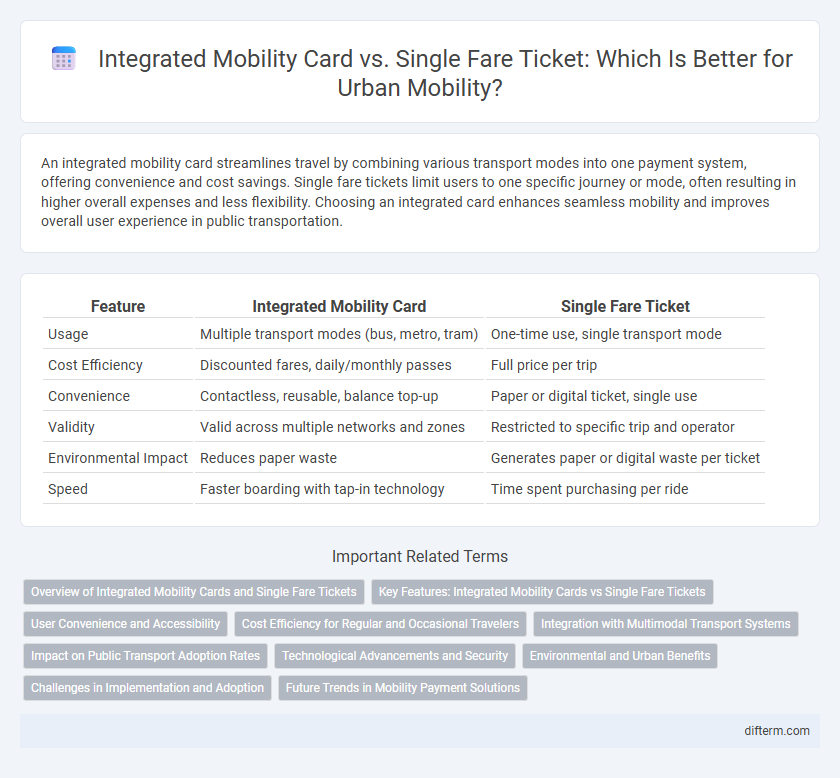An integrated mobility card streamlines travel by combining various transport modes into one payment system, offering convenience and cost savings. Single fare tickets limit users to one specific journey or mode, often resulting in higher overall expenses and less flexibility. Choosing an integrated card enhances seamless mobility and improves overall user experience in public transportation.
Table of Comparison
| Feature | Integrated Mobility Card | Single Fare Ticket |
|---|---|---|
| Usage | Multiple transport modes (bus, metro, tram) | One-time use, single transport mode |
| Cost Efficiency | Discounted fares, daily/monthly passes | Full price per trip |
| Convenience | Contactless, reusable, balance top-up | Paper or digital ticket, single use |
| Validity | Valid across multiple networks and zones | Restricted to specific trip and operator |
| Environmental Impact | Reduces paper waste | Generates paper or digital waste per ticket |
| Speed | Faster boarding with tap-in technology | Time spent purchasing per ride |
Overview of Integrated Mobility Cards and Single Fare Tickets
Integrated mobility cards streamline public transportation by consolidating access to buses, trains, and trams into a single, reloadable card, enhancing convenience and reducing transaction times. Single fare tickets provide a straightforward, pay-per-ride option suitable for occasional use but lack the flexibility and cost benefits of integrated cards. Urban transit systems increasingly prioritize integrated mobility cards to promote seamless travel, reduce fare evasion, and support multimodal transport networks.
Key Features: Integrated Mobility Cards vs Single Fare Tickets
Integrated mobility cards offer seamless access across multiple transportation modes such as buses, trains, and bike-sharing systems, enabling real-time fare deductions and reducing transaction times. Single fare tickets are limited to specific trips or modes, requiring purchase for each journey and often lacking interoperability between transport services. The key advantage of integrated mobility cards lies in convenience, cost-efficiency through capped fares or discounts, and enhanced data collection for transit planning.
User Convenience and Accessibility
Integrated mobility cards streamline travel by consolidating multiple transport services into a single payment method, enhancing user convenience through seamless transfers and reduced transaction times. These cards offer greater accessibility by supporting contactless payments, mobile app integration, and broad acceptance across buses, trains, and bike-sharing systems. In contrast, single fare tickets often limit flexibility, requiring users to purchase separate tickets for different modes, leading to longer wait times and increased complexity in urban transit.
Cost Efficiency for Regular and Occasional Travelers
Integrated mobility cards offer significant cost efficiency for regular travelers by providing discounted multi-modal access and eliminating repeated purchase fees, which reduces overall commuting expenses. Occasional travelers benefit from single fare tickets by avoiding upfront card costs and paying only for individual journeys, making it more economical for infrequent use. Comparing both options, integrated cards maximize savings through fare capping and seamless transfers, whereas single tickets cater to cost-conscious users with sporadic mobility needs.
Integration with Multimodal Transport Systems
Integrated mobility cards streamline access by combining payment and ticketing across multiple transport modes, including buses, trams, trains, and bike-sharing services, enhancing seamless travel. Single fare tickets typically limit usage to one mode or operator, reducing convenience and requiring separate purchases for transfers. Multimodal integration through mobility cards optimizes journey coordination, reduces transaction times, and supports real-time fare adjustments for complex routes.
Impact on Public Transport Adoption Rates
Integrated mobility cards streamline access to multiple transportation modes, significantly increasing public transport adoption rates by offering convenience and cost savings. Single fare tickets limit flexibility, often deterring users from combining different transport options, which restricts overall ridership growth. Research shows cities implementing integrated cards experience up to a 25% rise in multimodal transit usage compared to those relying solely on single fare ticket systems.
Technological Advancements and Security
Integrated mobility cards leverage advanced encryption and contactless payment technologies, enhancing transaction speed and security compared to single fare tickets. These cards support multi-modal transport access by seamlessly consolidating payments across buses, trains, and bike-sharing systems within a unified digital platform. The robust authentication protocols embedded in integrated mobility cards reduce fraud risks, offering a safer and more efficient travel experience for users.
Environmental and Urban Benefits
Integrated mobility cards reduce paper waste by consolidating multiple transit options into a single, reusable medium, significantly lowering the environmental footprint compared to single fare tickets. Urban congestion decreases as integrated cards encourage multimodal transport usage, optimizing public transit efficiency and reducing reliance on private vehicles. This shift fosters cleaner air quality and enhances urban sustainability by minimizing carbon emissions and traffic-related pollution.
Challenges in Implementation and Adoption
Integrated mobility cards encounter challenges such as the need for extensive infrastructure upgrades and coordination among multiple transport operators, which can delay implementation. User adoption is hindered by limited interoperability across regions and a lack of awareness or trust in new technologies. Single fare tickets, while simpler, face resistance due to inconvenience for multi-modal travelers and higher transaction costs over time.
Future Trends in Mobility Payment Solutions
Integrated mobility cards streamline access across multiple transport modes, offering seamless payment experiences that enhance urban mobility efficiency. Future trends emphasize contactless technology and mobile wallet integration, enabling real-time fare adjustments and personalized travel solutions. Single fare tickets, while still relevant for occasional users, face declining adoption as integrated systems provide greater convenience and data-driven optimization.
integrated mobility card vs single fare ticket Infographic

 difterm.com
difterm.com